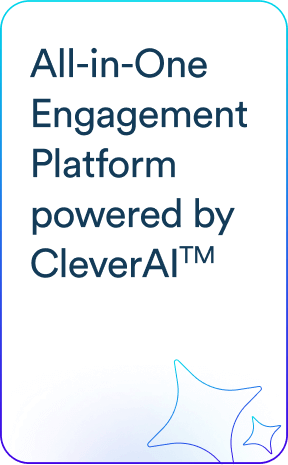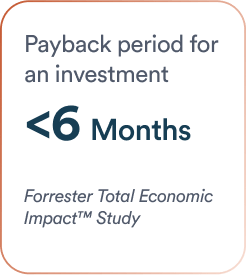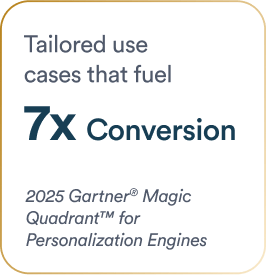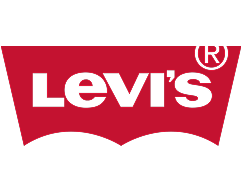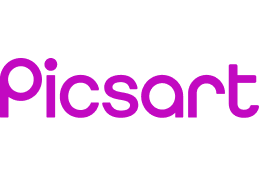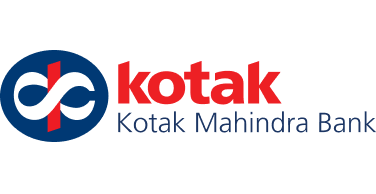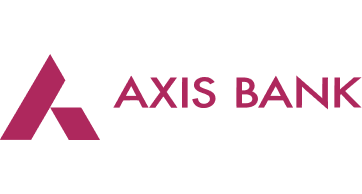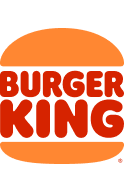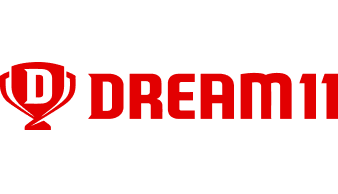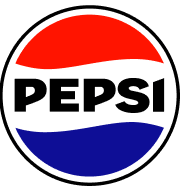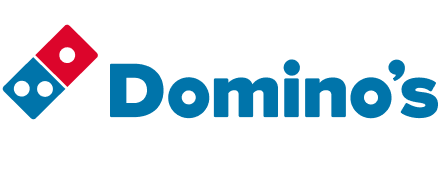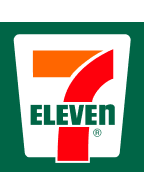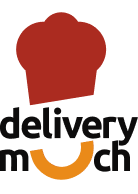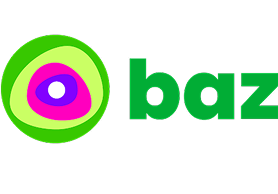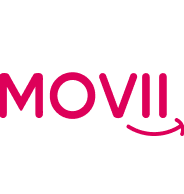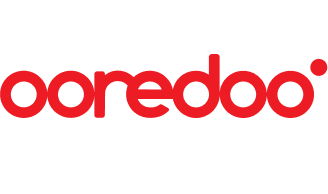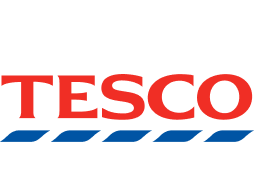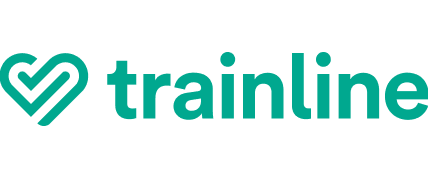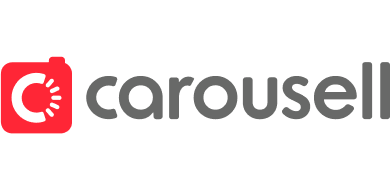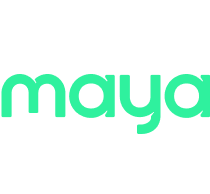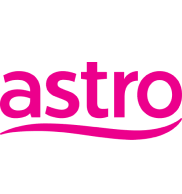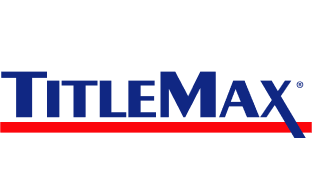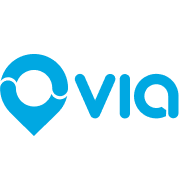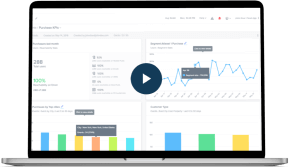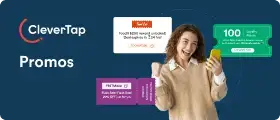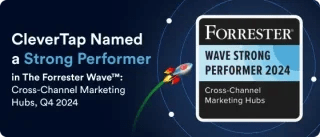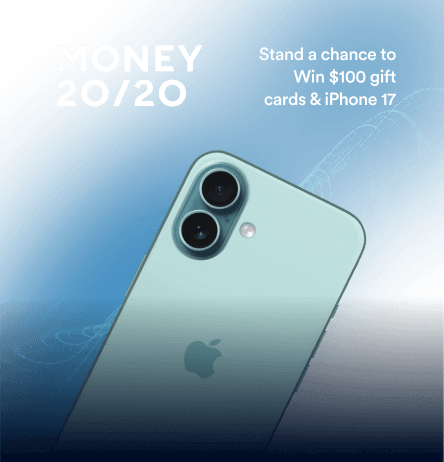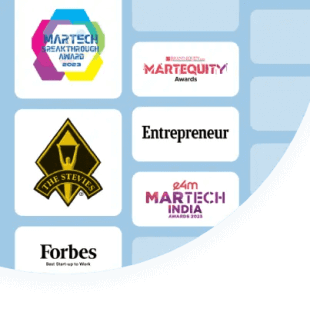Retail and store loyalty programs are strategic initiatives designed to reward repeat customers and foster a stronger relationship with a brand. Instead of focusing on one-off purchases, these programs build lasting engagement by offering points, discounts, or exclusive perks to frequent shoppers.
Loyalty programs help retailers boost retention and increase customer lifetime value. By encouraging shoppers to return, these programs gather valuable customer insights through purchase data that fuel personalized marketing and customer experiences.
What are Retail Loyalty Programs?
A retail loyalty program is a structured rewards scheme used by a retail brand to incentivize repeat purchases and foster customer loyalty. They are aimed at building strong, long-term connections between a brand and its shoppers.
Typically, these programs issue members a card or app account to earn points or rewards based on spending. For example, a store might award 1 point for each dollar spent, redeemable for discounts or free products later. Over time, this shifts the relationship from a single transaction to an ongoing value exchange between customer and retailer.
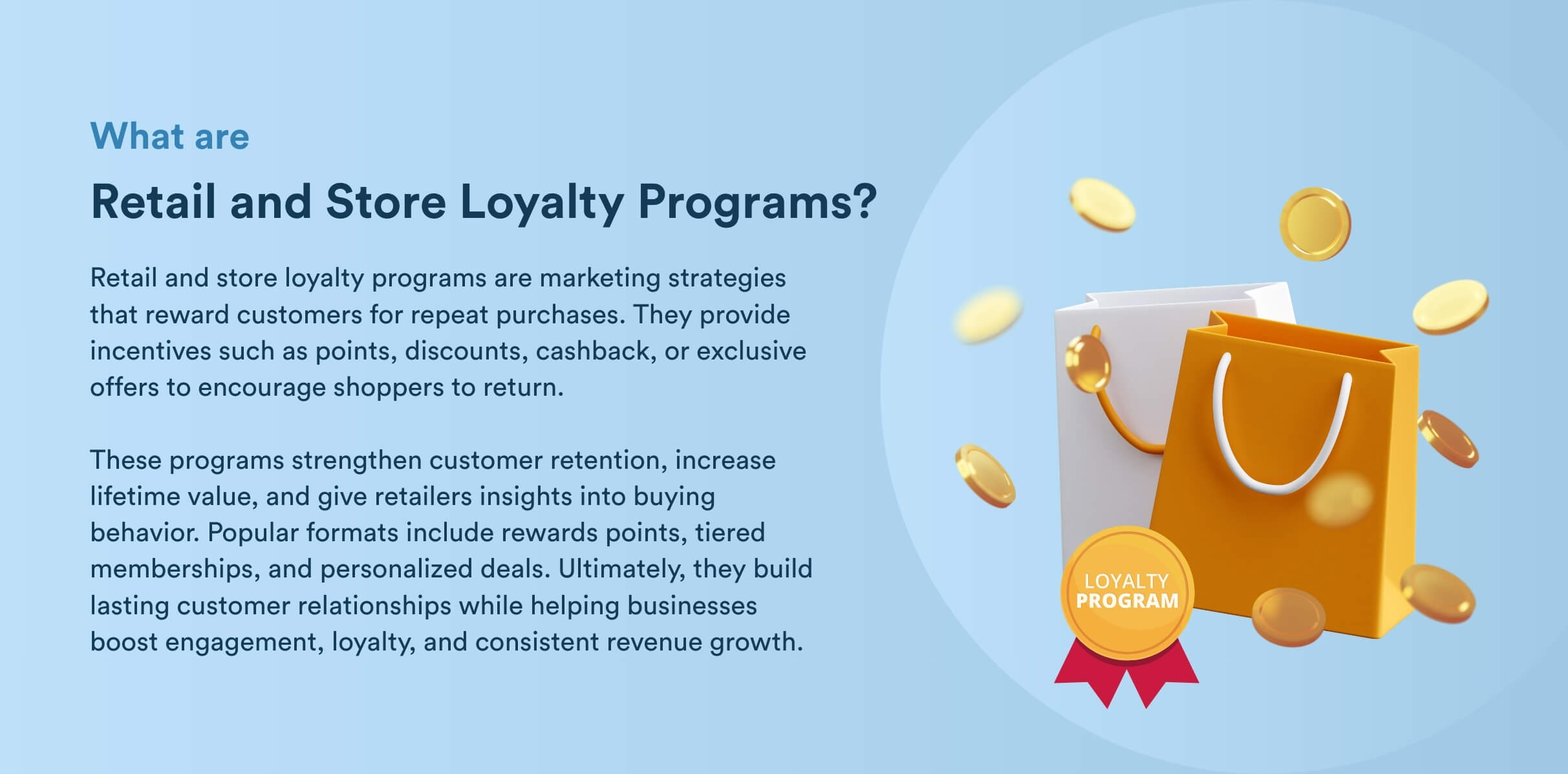
Key Aspects of a Retail Customer Loyalty Program
- Personalization: Modern programs use purchase history and customer preferences to tailor offers. Retailers collect data, sometimes even voluntary zero-party data, through loyalty memberships to send targeted promotions or product recommendations that make customers feel valued.
- Clear Rewards Structure: Common formats include points per purchase, tiered status levels, and stamp cards for freebies. Rewards might be discounts, free items, or access to exclusive events. The key is that earned rewards feel attainable but still motivate continued spending.
- Omnichannel Convenience: Customers shop both online and in-store. Effective loyalty programs integrate these channels so rewards and points follow the shopper seamlessly. For example, points earned on a website purchase can be redeemed at a physical store without hassle.
- Technology and Analytics: Most leading retail loyalty programs run on digital platforms or apps. Brands leverage technology such as AI/ML to track behavior and automatically serve personalized deals or alerts. For instance, retailers might use apps to send real-time coupons when a loyal customer enters a store or browses online, enhancing engagement and redemption rates.
- Emotional Engagement: Beyond points, some programs build community or exclusivity. For example, loyalty members might receive birthday surprises, early access to sales, or invitations to member-only events. These perks create an emotional bond, and customers feel like insiders or VIPs, which can deepen loyalty beyond mere transactions.
What are Store Loyalty Programs?
Store loyalty programs operate on the same principles but are often tied to a specific store or chain, especially in grocery, pharmacy, or convenience retail. They reward purchases made at those store locations or on the store’s website. For example, a grocery chain’s loyalty card might earn fuel points and coupons on every grocery purchase.
The main difference between store and retail loyalty is often the scope. While retail loyalty can cover omnichannel brands, store loyalty emphasizes rewards for shopping at specific store outlets. In practice, many retail brands with stores treat their program as both a retail and store loyalty initiative. What matters is giving customers incentives that encourage them to choose that store repeatedly.
Benefits of Customer Loyalty Programs in Retail
Loyalty programs offer multiple business advantages:
- Increased Customer Retention: Loyal customers buy more often. A 5% boost in retention can drive more than 25% profit. By rewarding repeat visits, retailers keep shoppers from defecting to competitors.
- Higher Lifetime Value: Members of loyalty programs typically spend more per visit and shop more frequently, raising average order value (AOV) and overall customer lifetime value (CLV). For example, by earning points or tiered status, customers are motivated to concentrate their purchases on one brand to maximize rewards.
- Valuable Customer Insights: When customers join a program and make purchases, they essentially volunteer data. Retailers learn each member’s preferences, purchase history, and demographics. This insight allows highly targeted marketing, such as sending coupons for products a customer buys, or creating segments, e.g., “fresh-food shoppers” vs. “electronics buyers” for tailored campaigns.
- Enhanced Customer Experience: Loyalty programs signal appreciation. Customers enjoy the feeling of being recognized. Receiving a personalized offer or a birthday gift improves their shopping experience. This positive reinforcement makes shopping more satisfying, turning routine transactions into engaging, valued interactions.
- Reduced Churn: Rewarding repeat business directly combats the churn problem. When customers earn perks with each purchase, they are less likely to jump to a competitor and leave points on the table.
- Competitive Differentiation: In a crowded market, a compelling loyalty program sets a retailer apart. Exclusive member benefits, such as VIP events and special promotions, make customers feel privileged. For example, upscale retailers now offer concierge services or first looks at new collections to top-tier members. These unique perks give shoppers a reason to choose one brand over others.
- Word-of-Mouth Referrals: Satisfied loyalty members often spread the word. Some programs add refer-a-friend bonuses, creating a viral effect. As happy members bring in friends or family for extra rewards, the retailer gains new customers cost-effectively.
Learn more about the strategic benefits of customer loyalty programs and how they strengthen retention and revenue.
How to Build a Retail Customer Loyalty Program?
Building an effective program typically involves these steps:
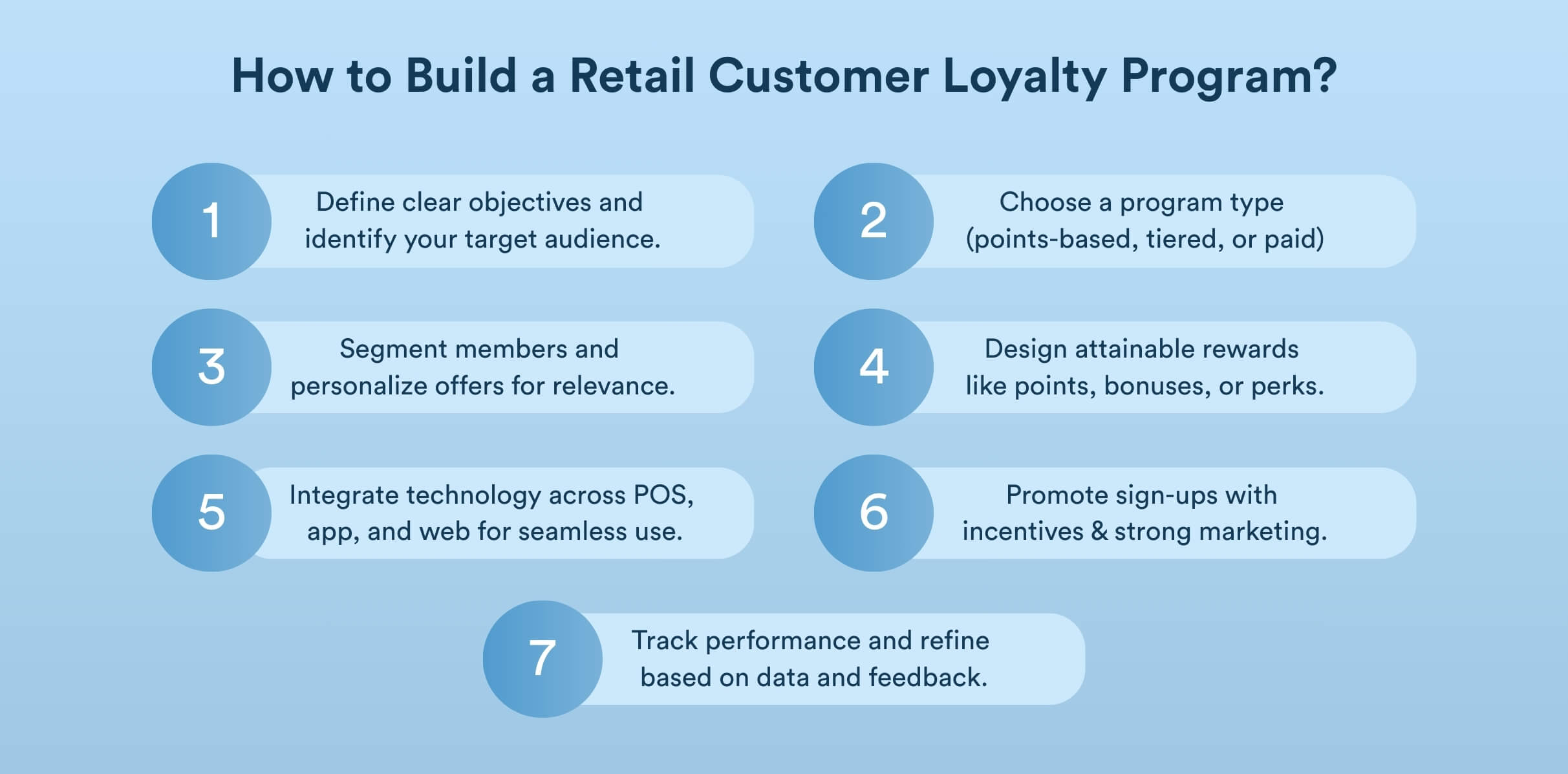
- Define Objectives and Audience: Clarify goals that are specific, measurable, achievable, relevant, and time-bound. For example, increase repeat visits by X% over the next two months, and identify your best customers.
- Choose a Program Type: Decide on a model that fits your brand and audience. High-frequency retailers often use points-based systems, while luxury retailers might offer invitation-only status tiers. Paid membership can work for brands with already loyal fan bases.
- Segment and Personalize: Use the program data to segment your members. Tailor communications with personalized offers. For example, a loyalty member who buys baby products might get targeted coupons for diapers or formula.
- Design the Rewards: Map out how customers earn rewards and what they get. Common tactics include points per dollar, milestone bonuses, tier upgrades, or surprise perks. Ensure the math makes sense, and rewards should feel attainable but still encourage further spending.
- Integrate Technology: Implement the program via a digital platform, mobile app, or web portal, and integrate it with your point-of-sale and e-commerce systems. This way, customers redeem seamlessly whether shopping online or in-store.
- Promote the Program: Market the program aggressively. Offer sign-up incentives to encourage enrollment. Train staff to mention the program at checkout and highlight its benefits on marketing channels.
- Measure and Iterate: Track key metrics from members and gather feedback. Use these insights to tweak the program, add new rewards, adjust earn rates, or run special promotions to boost engagement.
Types of Loyalty Programs for the Retail Industry
Retailers can choose from various loyalty models, each tapping into different customer motivations:
- Points-Based Programs: Customers earn points for purchases. The accumulated points are redeemed for rewards like discounts or free items. They are popular because they are simple and encourage repeat spending. Many grocery stores and fuel use this program, where points translate to cents off per gallon or dollar.
- Tiered Programs: Shoppers achieve higher status levels (silver/gold/platinum) based on spend thresholds. Each tier offers better perks. For instance, gold members might earn points faster or enjoy free shipping. This gamified approach motivates customers to climb tiers by spending more or staying active, while rewarding top customers with VIP treatment. Airlines and fashion retailers often use tiered models.
- Paid/Subscription Programs: Customers pay a monthly or yearly membership fee for enhanced benefits. For a flat annual fee, members get free fast shipping, streaming media, exclusive deals, etc. This model generates upfront revenue and encourages heavy usage as members tend to shop more often to justify the subscription cost. Amazon Prime is a typical example.
- Referral-Based Programs: Members earn rewards for bringing in new customers. After referring a friend who signs up or makes a purchase, the original member gets bonus points or discounts. This turns loyal customers into brand ambassadors. It’s especially effective for growing the customer base in a cost-efficient way, as you leverage the enthusiasm of existing fans.
- Coalition/Partnership Programs: Two or more brands team up on a shared rewards program. For example, a retail store might partner with a local gas station so members earn fuel pump points for shopping, or with an airline to earn frequent-flyer miles. By pooling loyalty perks, businesses can offer richer rewards and tap into each other’s customer networks.
- Other Variants: Some retailers offer instant rewards or cashback programs. Others use gamification, like digital badges, challenges, and social engagement, to keep customers interested. The choice depends on what best engages your target shopper demographic.
15 Retail and Store Loyalty Program Examples
Here are 15 real-world loyalty programs from retailers, each illustrating different strategies:
1. Starbucks Rewards
Why does the Starbucks Rewards program work?
- Stars quickly translate into free drinks, food, or merchandise, making rewards tangible and motivating frequent visits.
- Members enjoy personalized offers, free refills on brewed coffee/tea, birthday treats, and exclusive games and challenges, creating ongoing engagement.
- They can earn stars by paying with cash, card, or app, removing barriers to participation.
- Collaborations with other brands let members earn Stars beyond Starbucks, widening the program’s value.
- Rewards transform routine coffee runs into experiences, fostering loyalty and community.
- Starbucks tailors offers and communications based on each member’s preferences and habits, boosting relevance and retention rate.
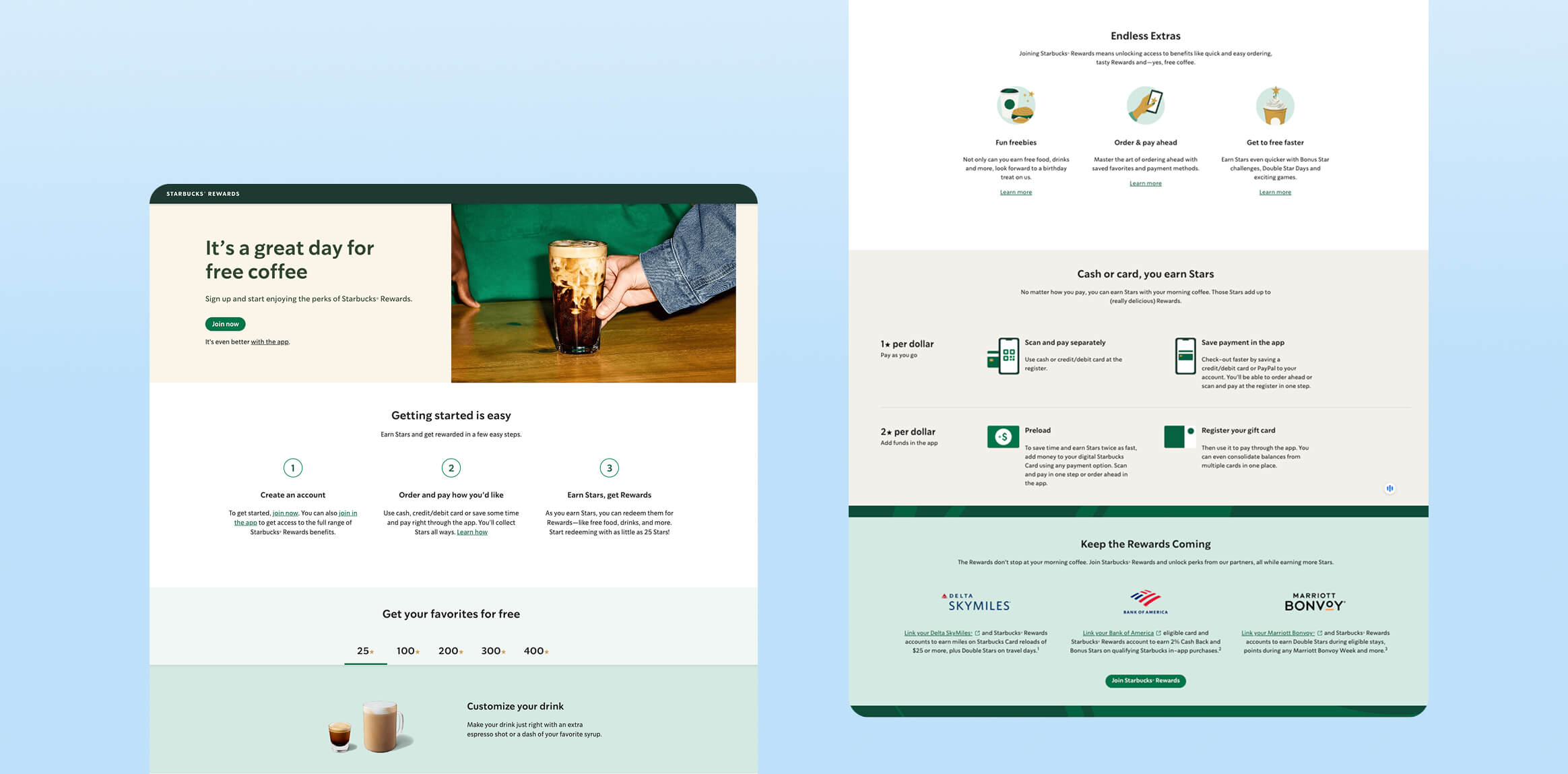
2. IKEA Family
IKEA’s free loyalty club offers simple but attractive perks, and here’s why it works.
- Members get discounts on select products, free coffee or tea at the store, and special offers during store visits. The familiarity and extra value, like free in-store refreshments, make shopping more inviting.
- Early access to product launches and sales makes customers feel like insiders, and free membership lowers the barrier to entry and drives mass adoption.
- IKEA learns shopper preferences while offering genuine value in return. The brand communicates with members via email and in-app notifications about upcoming promotions and product launches.
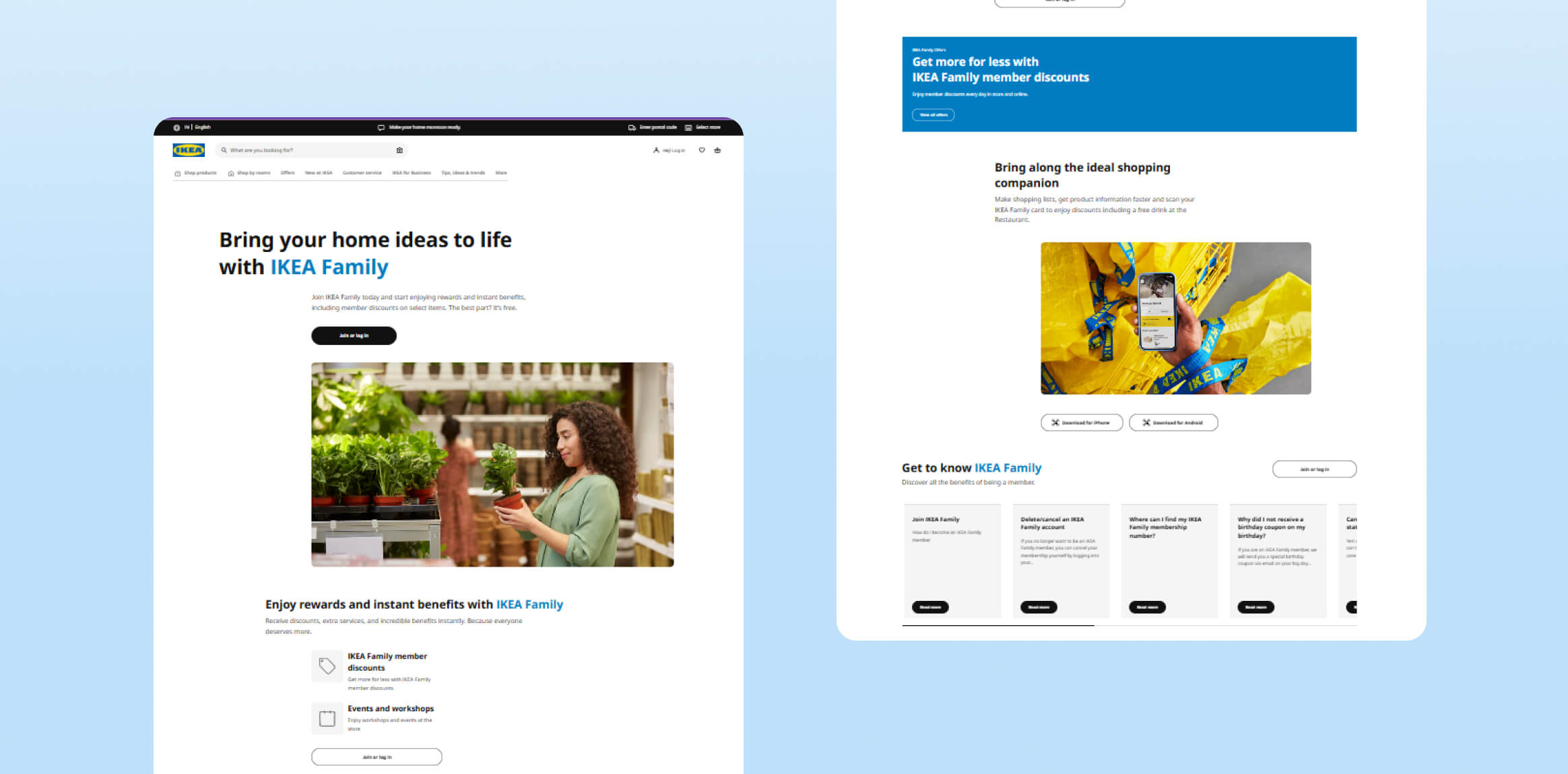
3. Amazon Prime
Amazon Prime runs a paid membership program that has become a cornerstone of retail loyalty. Here’s why it works.
- For an annual fee, members get unlimited free expedited shipping, access to streaming media, and exclusive deals.
- Benefits span retail, groceries, entertainment, and digital services, maximizing the program’s relevance to diverse users.
- Prime Video, Music, and gaming perks add non-retail benefits, making membership feel worthwhile beyond shopping.
- The subscription loyalty model keeps members shopping on Amazon far more frequently than non-members.
- Prime users rarely cancel because the bundled benefits far outweigh the cost. In essence, Prime transforms a retailer’s value proposition by making convenience and perks an ongoing service.
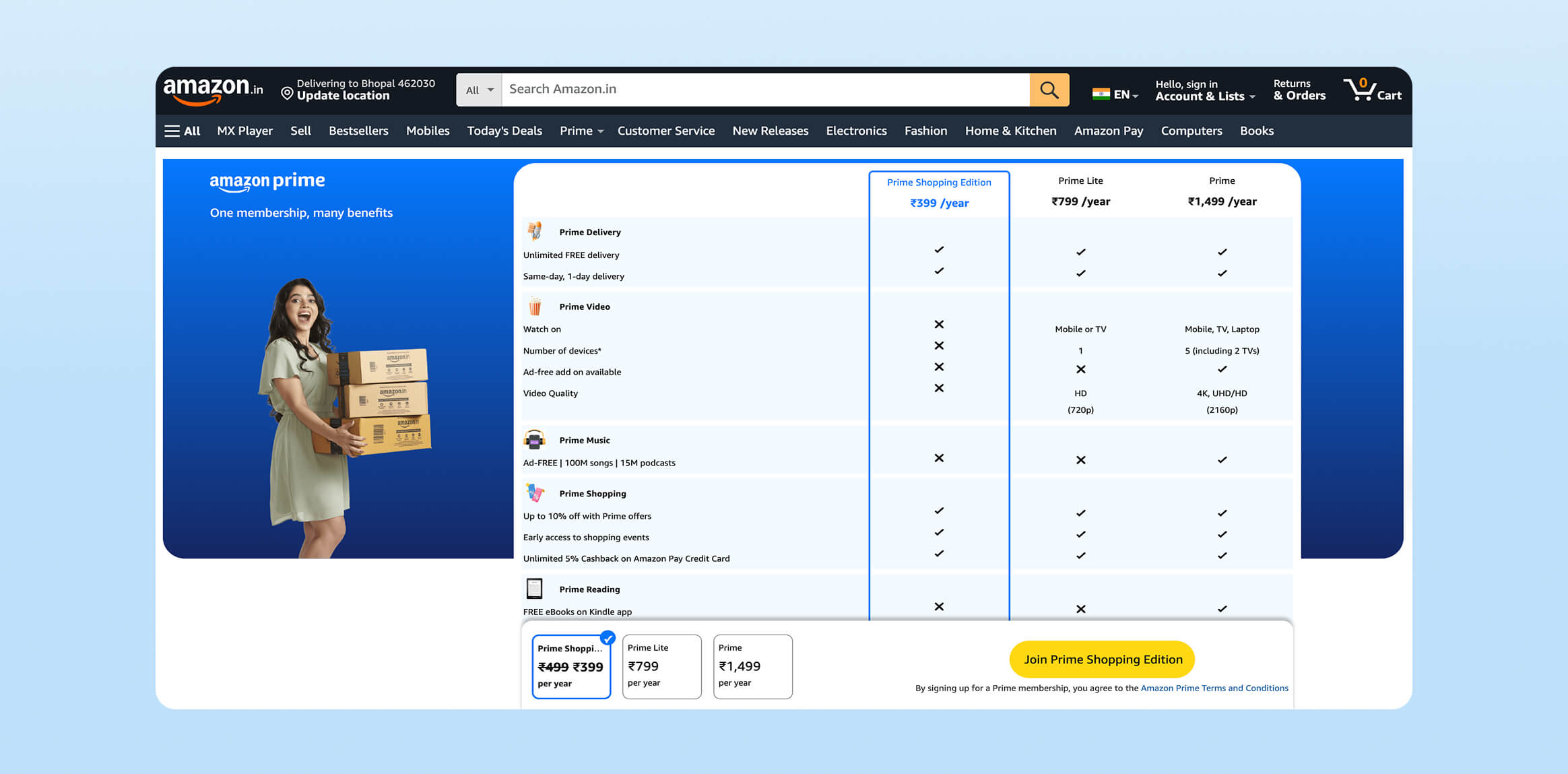
Planning your loyalty strategy? Make sure you understand the cost of building a loyalty program. Read our blog to learn more.
4. Samsung Rewards
Samsung’s tiered rewards structure works because:
- Samsung Rewards has tiers: Silver, Gold, and Platinum. This unlocks higher point multipliers as customers spend more, driving incremental revenue and incentivizing brand loyalty through gamification.
- Points across diverse touchpoints, keeping customers within Samsung’s ecosystem and boosting lifetime value through cross-category engagement.
- Points can be redeemed for product discounts, gift cards, or experiences, catering to different value perceptions and emotional triggers.
- Tiered users receive targeted promotions, fostering loyalty through tailored experiences. Samsung leverages loyalty data for predictive analytics, personalizing engagement, and maximizing ROI.
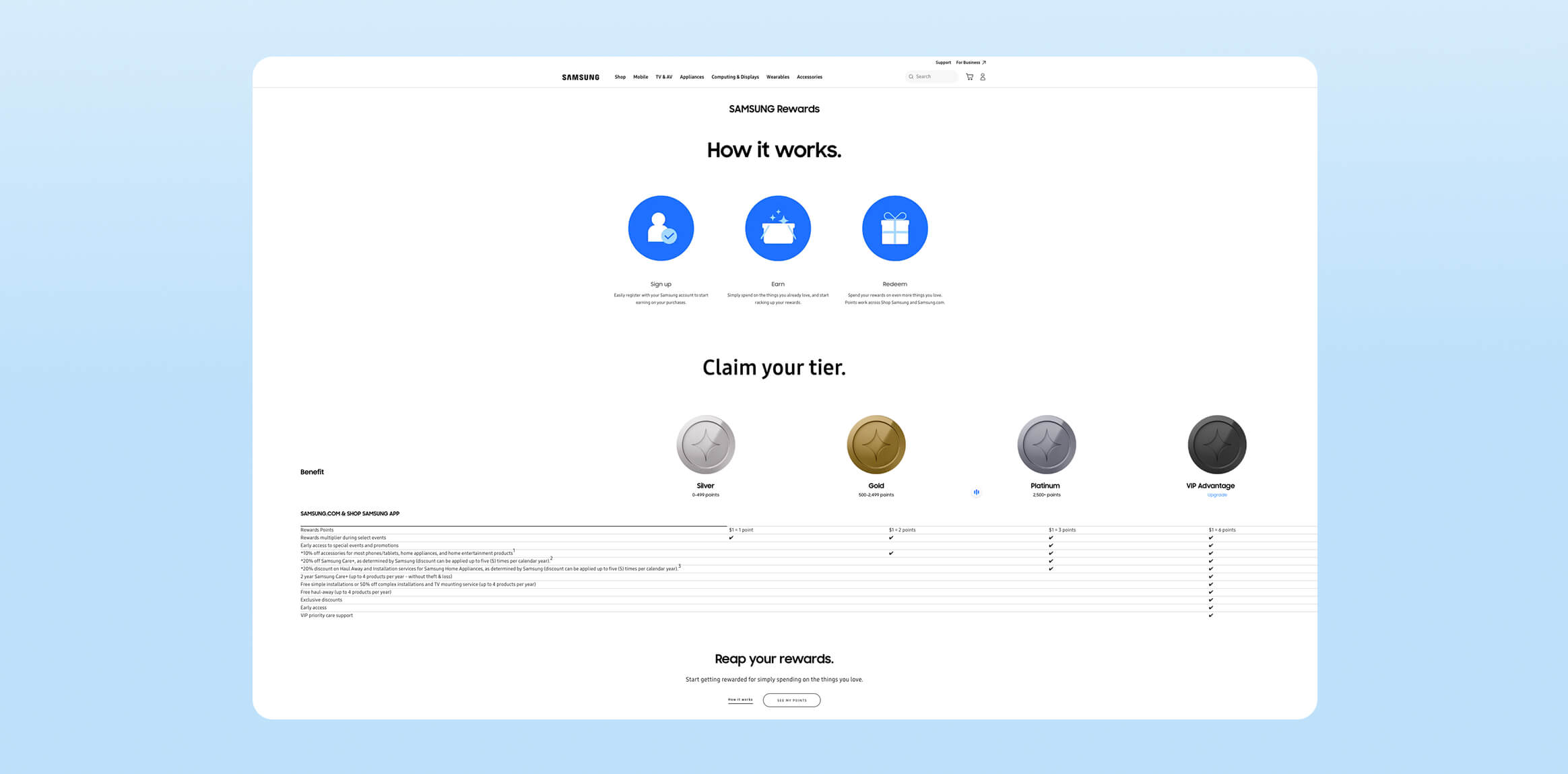
5. Nike Membership
Here’s why Nike’s membership program works.
- Nike prioritizes exclusive access, e.g., member-only products, early drops, over points, aligning with aspirational brand positioning and emotional loyalty rather than transactional loyalty.
- Membership weaves seamlessly into Nike’s apps: Nike Run Club, Nike Training Club, creating holistic engagement around health and fitness rather than just purchases.
- Challenges, virtual events, and personalized training foster a sense of community, tapping into psychological drivers like identity and social belonging.
- Benefits extend across digital and physical retail, ensuring consistency in member recognition and perks.
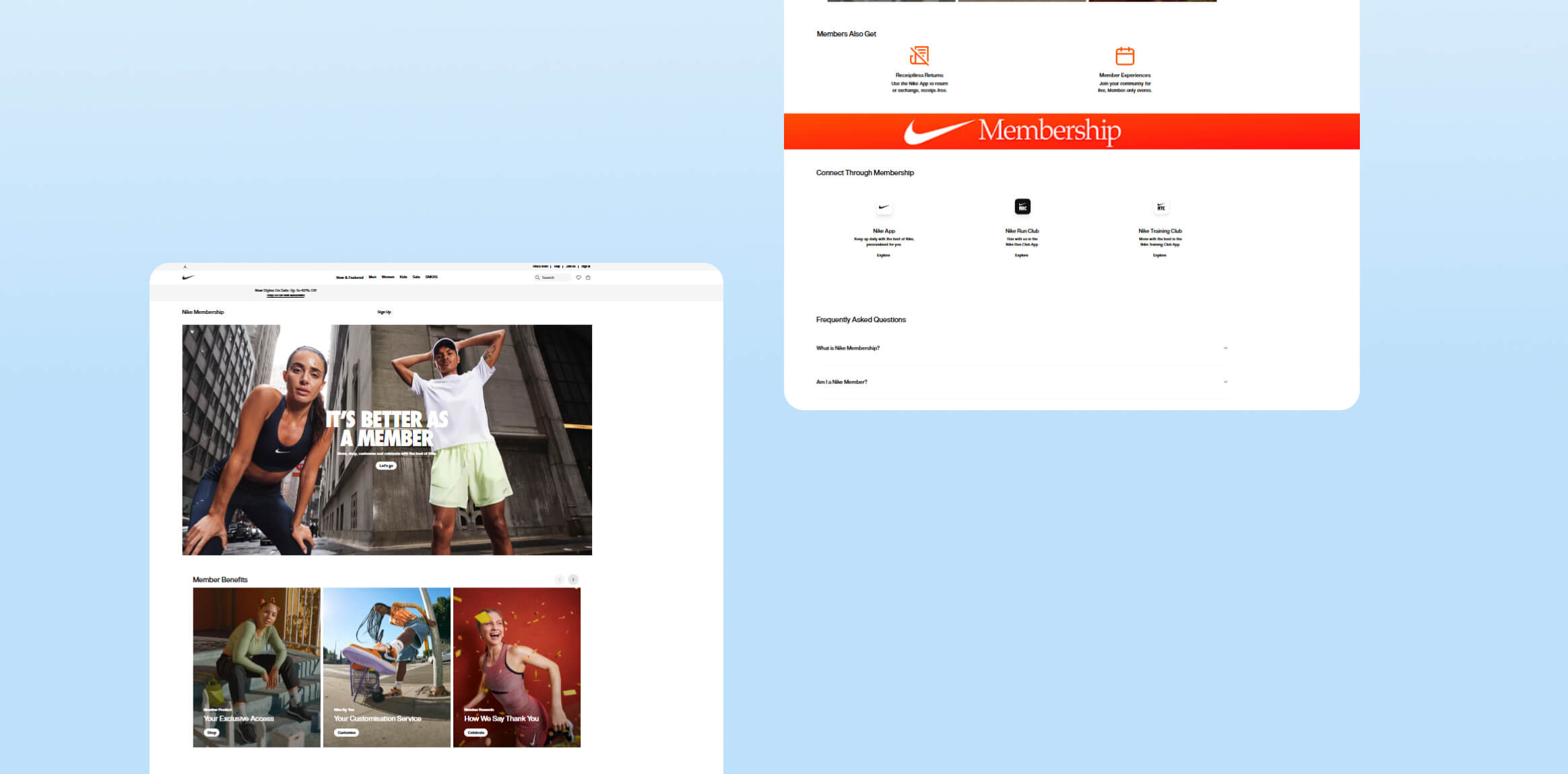
6. Nordstrom The Nordy Club
Here’s why Nordstrom’s tiered loyalty club rewards work:
- With four ascending tiers, Member, Influencer, Ambassador, and Icon, The Nordy Club motivates increasing spend to unlock perks like extra “Personal Double Points Days,” stylist services, and exclusive events.
- Base members earn 1 point per dollar, cardholders earn 2–3 points per dollar, encouraging credit‑card enrollment and boosting retailer margins through co‑branded financial products.
- Points automatically convert to Notes redeemable at Nordstrom Rack, creating seamless, omnichannel spend‑to‑redeem experiences.
- Benefits include early sale access, personal stylists, reimbursed alterations, free shipping, and in-home consultations, offering emotional value beyond transactional rewards.
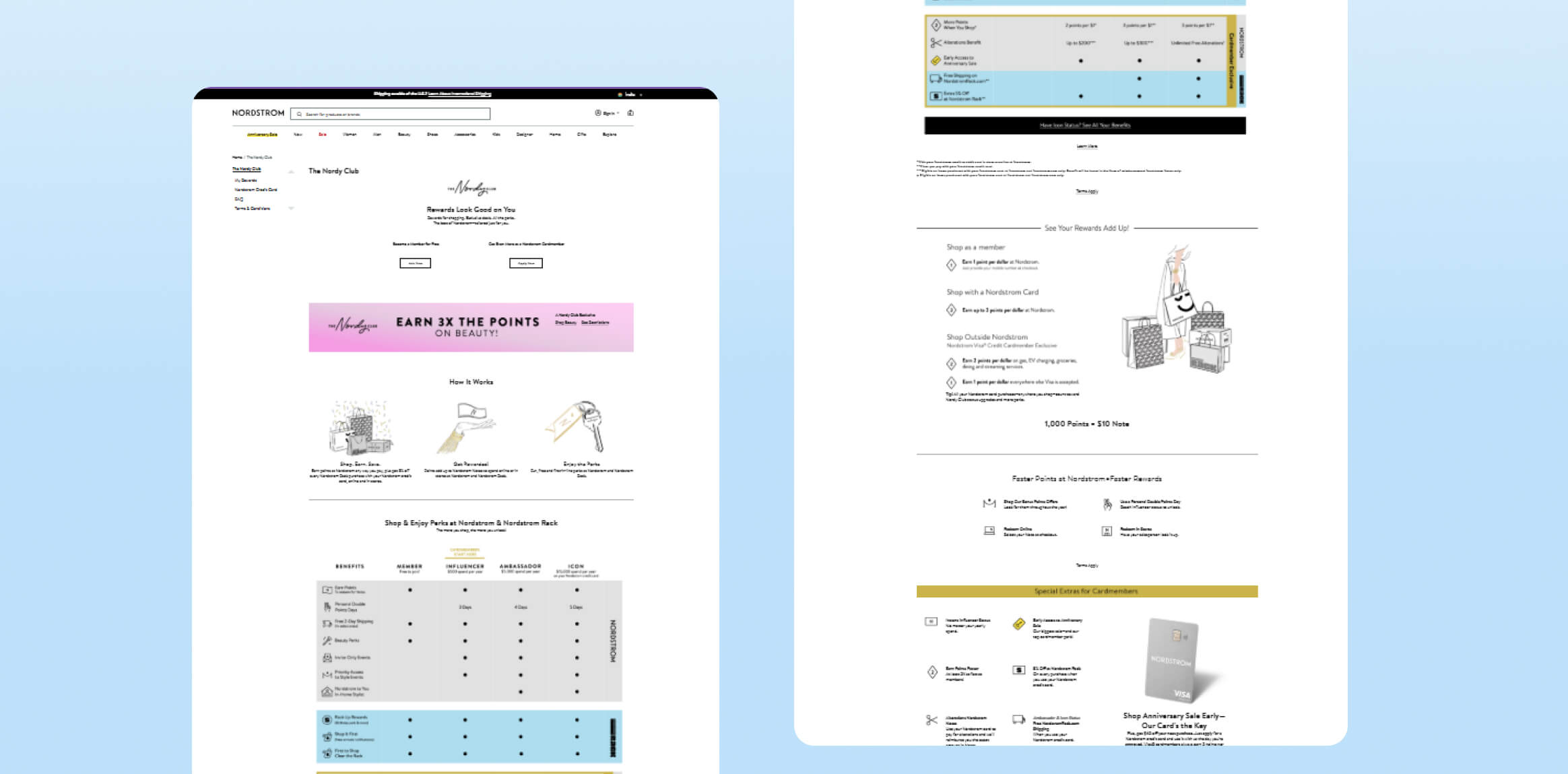
7. Sephora Beauty Insider
Why does Sephora’s tiered loyalty program, Beauty Insider, work?
- Insider, VIB, and Rouge tiers motivate higher spending to unlock better perks.
- Members earn 1 point per dollar, redeemable for products or discounts, keeping rewards tangible.
- Rewards Bazaar offers diverse redemption options, including full-size products and experiences.
- Members get early access to new products, sales, and limited editions, creating urgency and prestige.
- Annual birthday surprises delight members and encourage retention.
- Tailored offers and events make shoppers feel valued.
Higher tiers receive perks like free shipping, same-day delivery, and exclusive gifts, enhancing loyalty through VIP experiences.
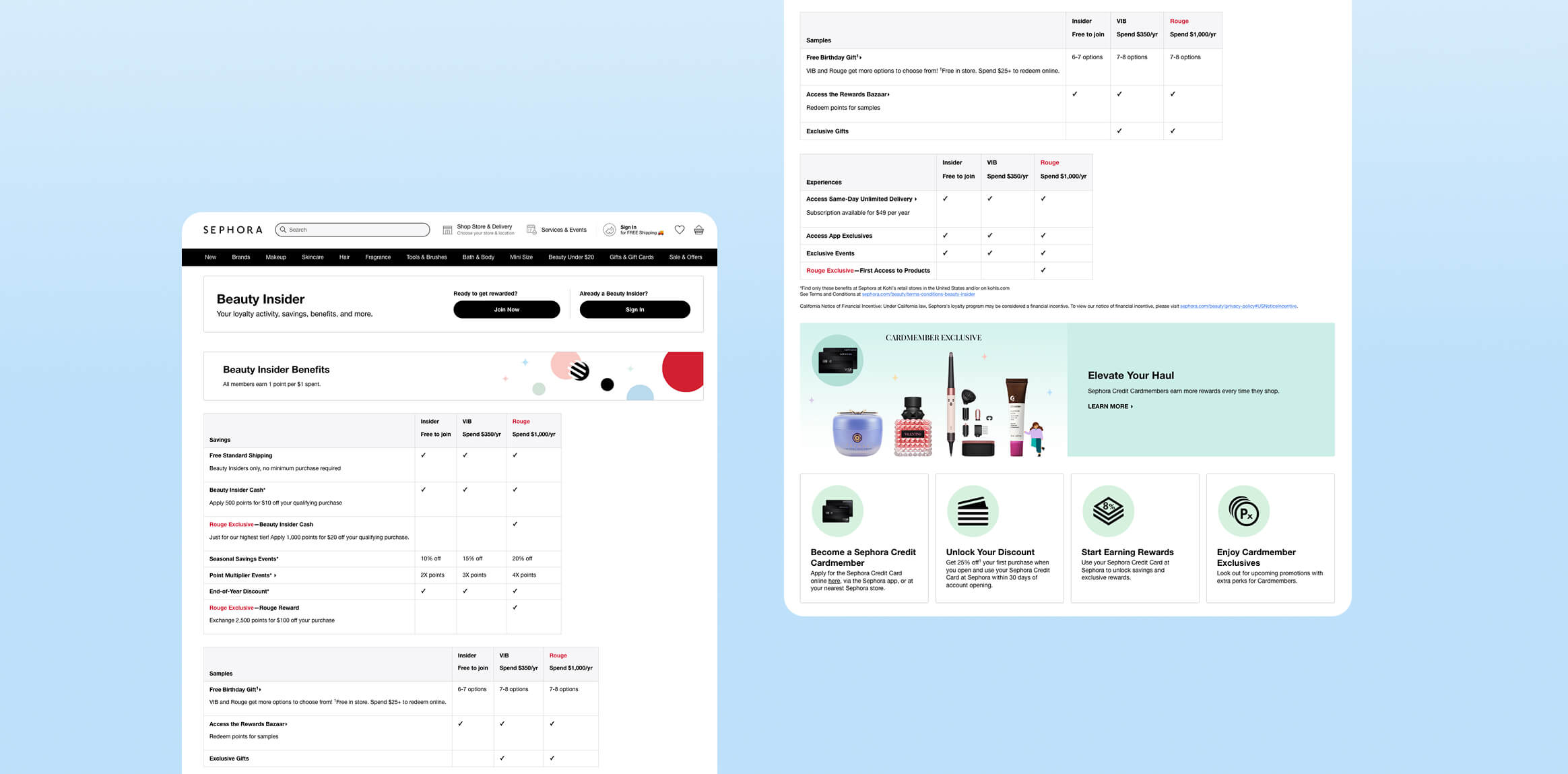
8. LEGO Insiders
Here’s why LEGO’s loyalty program works:
- Points can be redeemed instantly for discounts on future LEGO purchases, encouraging users to deepen brand interaction beyond the purchase moment.
- VIP members also gain early access to new sets and occasionally receive free LEGO products on special shopping occasions.
- By rewarding direct purchases and exclusive early availability, LEGO encourages fans to buy from official channels rather than third parties.
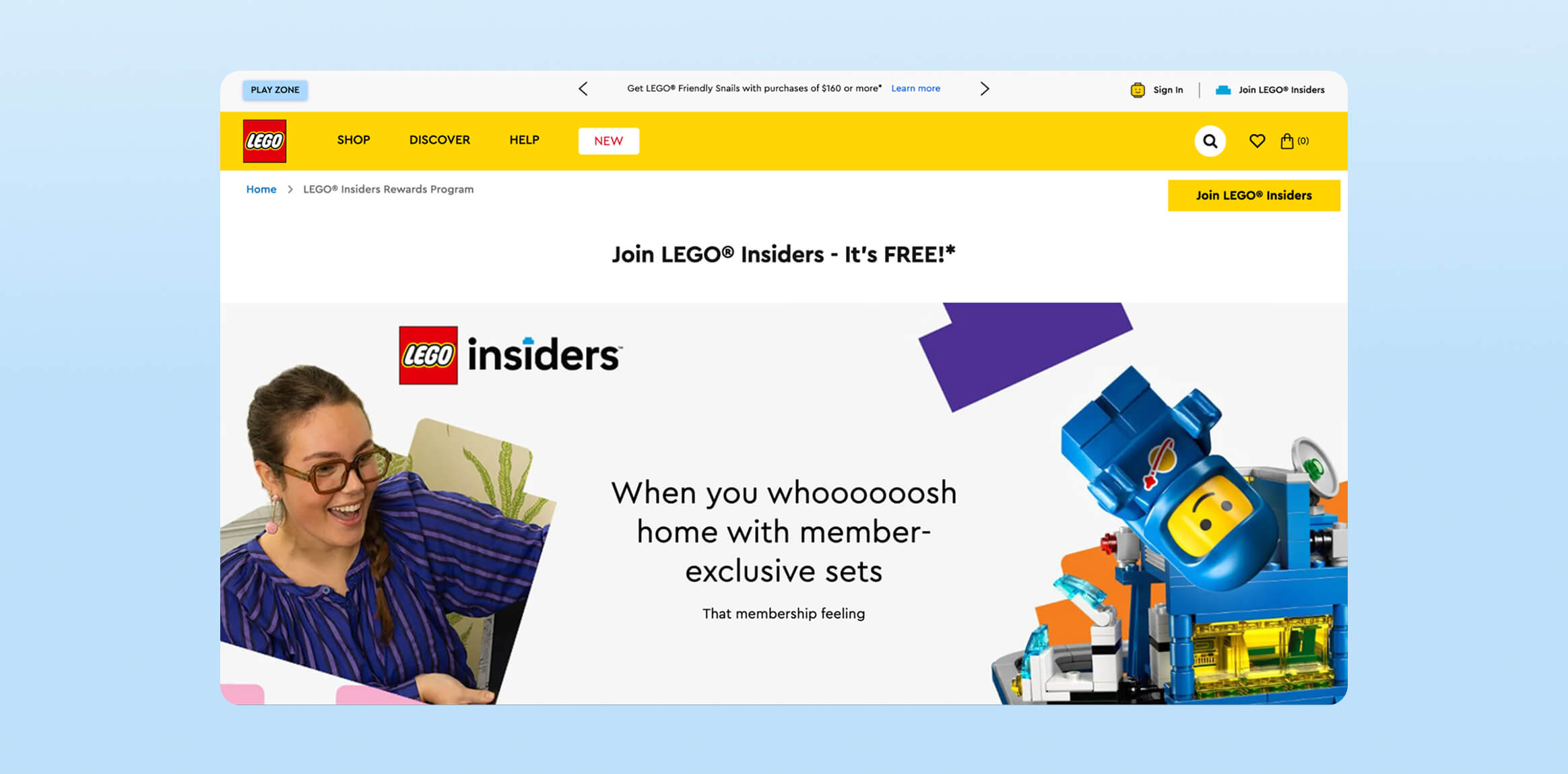
9. GameStop Pro Rewards
Why does GameStop Pro work as a retail loyalty program?
- A $25/year membership creates psychological sunk cost effects, increasing member engagement and purchase frequency to justify the fee.
- Instant 5% off almost all purchases, including collectibles and pre-owned games, drives higher AOV and differentiates GameStop from digital-only competitors.
- Rewards apply both online and in-store, crucial for blending digital and physical retail in a gaming market shifting toward digital distribution.
- The structure caters to avid gamers: frequent shoppers get rewards faster, and die-hard fans pay for extra benefits.
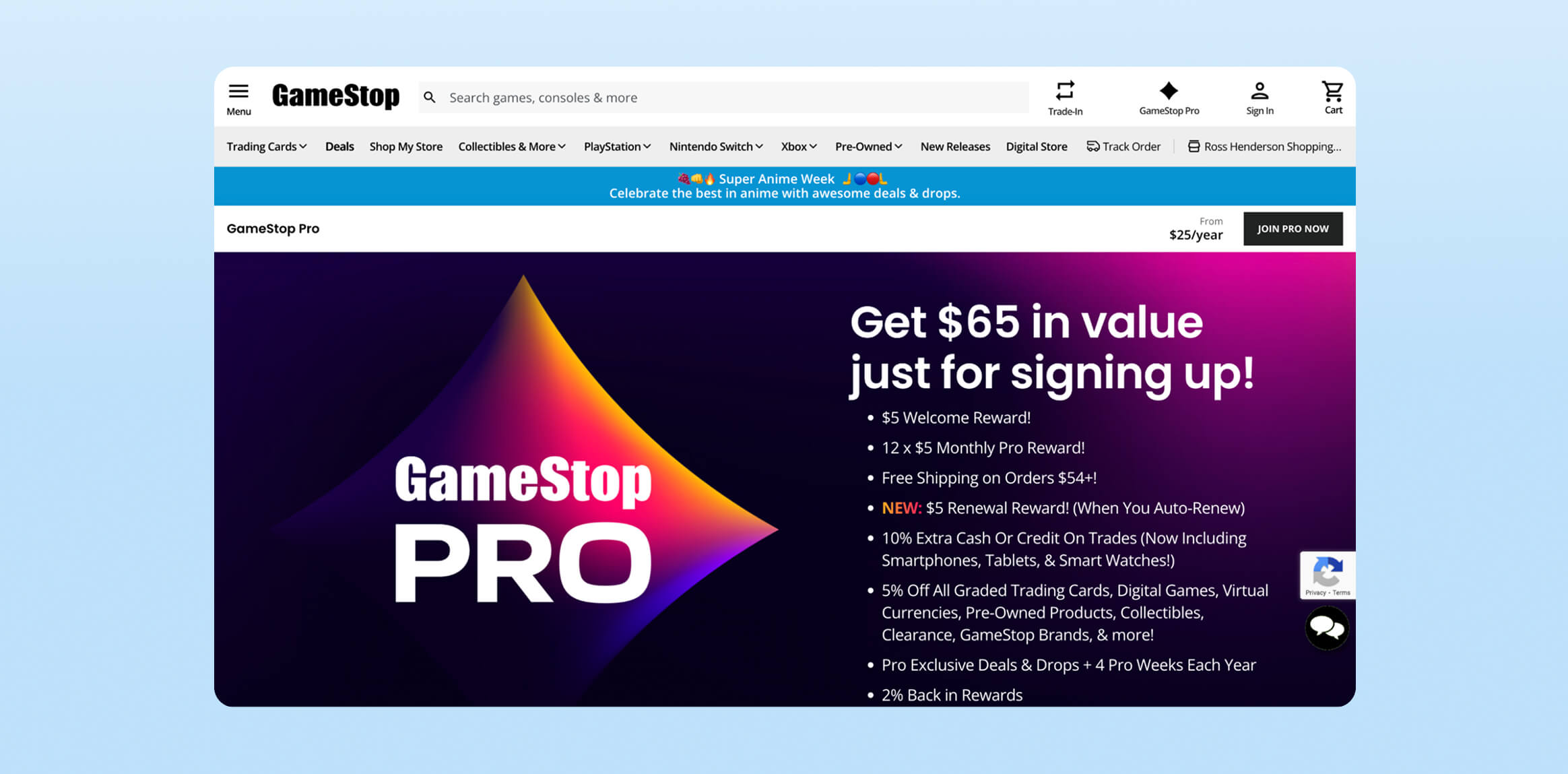
10. H&M Membership
What works in favour of the H&M Membership program?
- Two tiers: Core Member and Plus Member, reward higher spend with accelerated points earning, exclusive events, and unique experiences, motivating incremental revenue through aspirational progression.
- 15% off reward for dropping off old clothes in store, integrates loyalty with sustainability behaviors, turning ESG goals into measurable customer engagement.
- Early access to sales and exclusive collections appeals to fashion enthusiasts’ desire for exclusivity, driving emotional loyalty.
- Free enrollment maximizes participation, enabling H&M to collect first-party data at scale, crucial for personalized marketing.
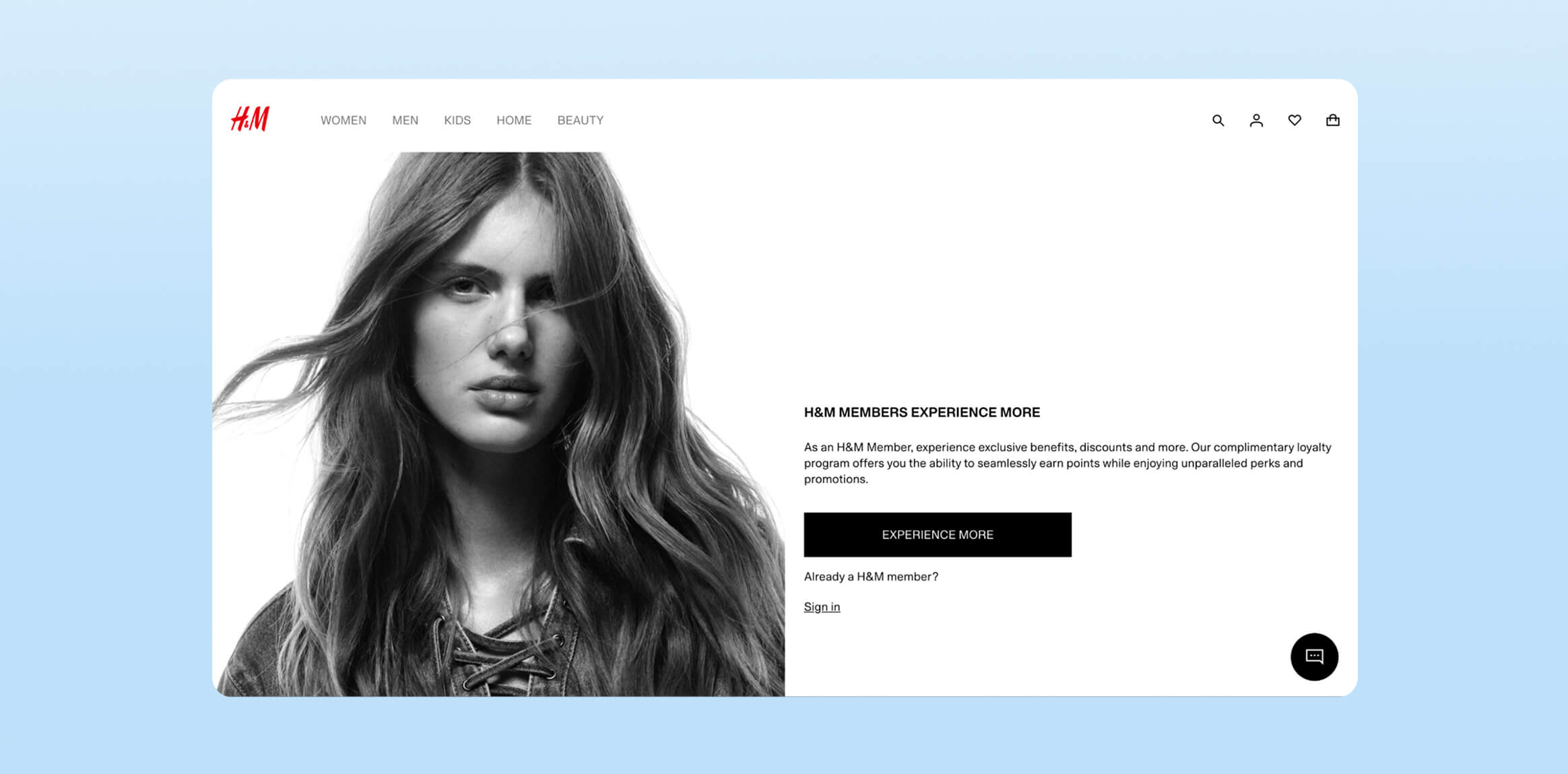
11. Dell Rewards
Why does Dell’s Retail Loyalty Program work?
- Rewards tied to future Dell purchases reduce competitive shopping, especially valuable in commoditized hardware markets.
- Rewards apply automatically at checkout, removing cognitive barriers that often suppress loyalty redemption rates.
- Technology purchases generally have large average order values, and earning 3% back in rewards can transform infrequent big-ticket buys into an ongoing relationship rather than a one-off transaction.
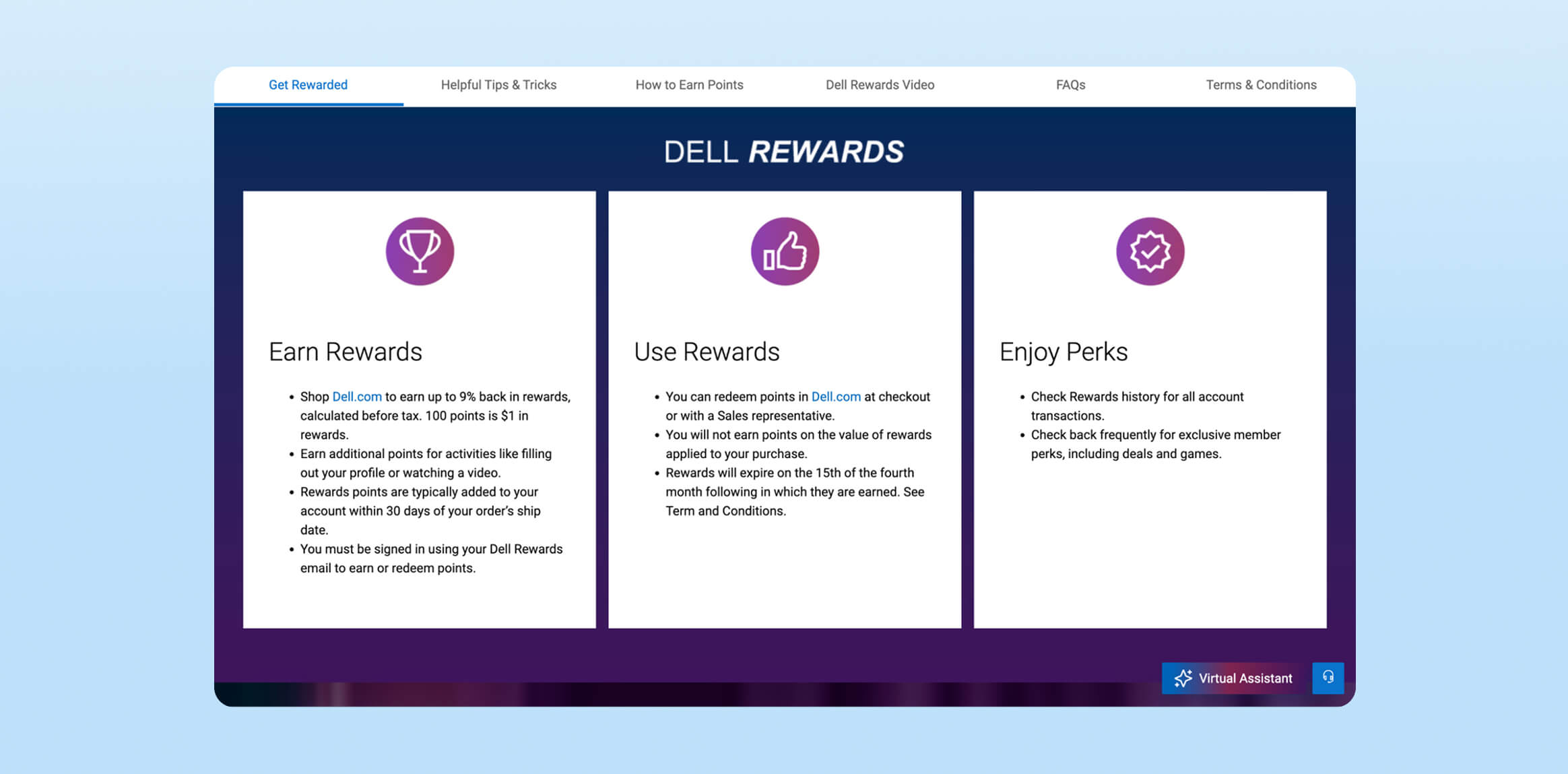
12. Gap Good Rewards
Here’s why GAP’s retail loyalty program works:
- One integrated rewards structure across Gap, Old Navy, Banana Republic, and Athleta simplifies value exchange and encourages cross-brand spending, supporting larger baskets and deeper brand loyalty.
- Three spending tiers unlock benefits like free fast shipping, exclusive discounts, early access, and a birthday bonus, driving aspirational spending and improved lifetime value.
- $1 = 100 points with reward increments enables instant gratification and limits redemption barriers, improving engagement.
- High‑frequency shoppers can be categorized by brand and tier, enabling personalized promotions and lifecycle campaigns across the brand portfolio.
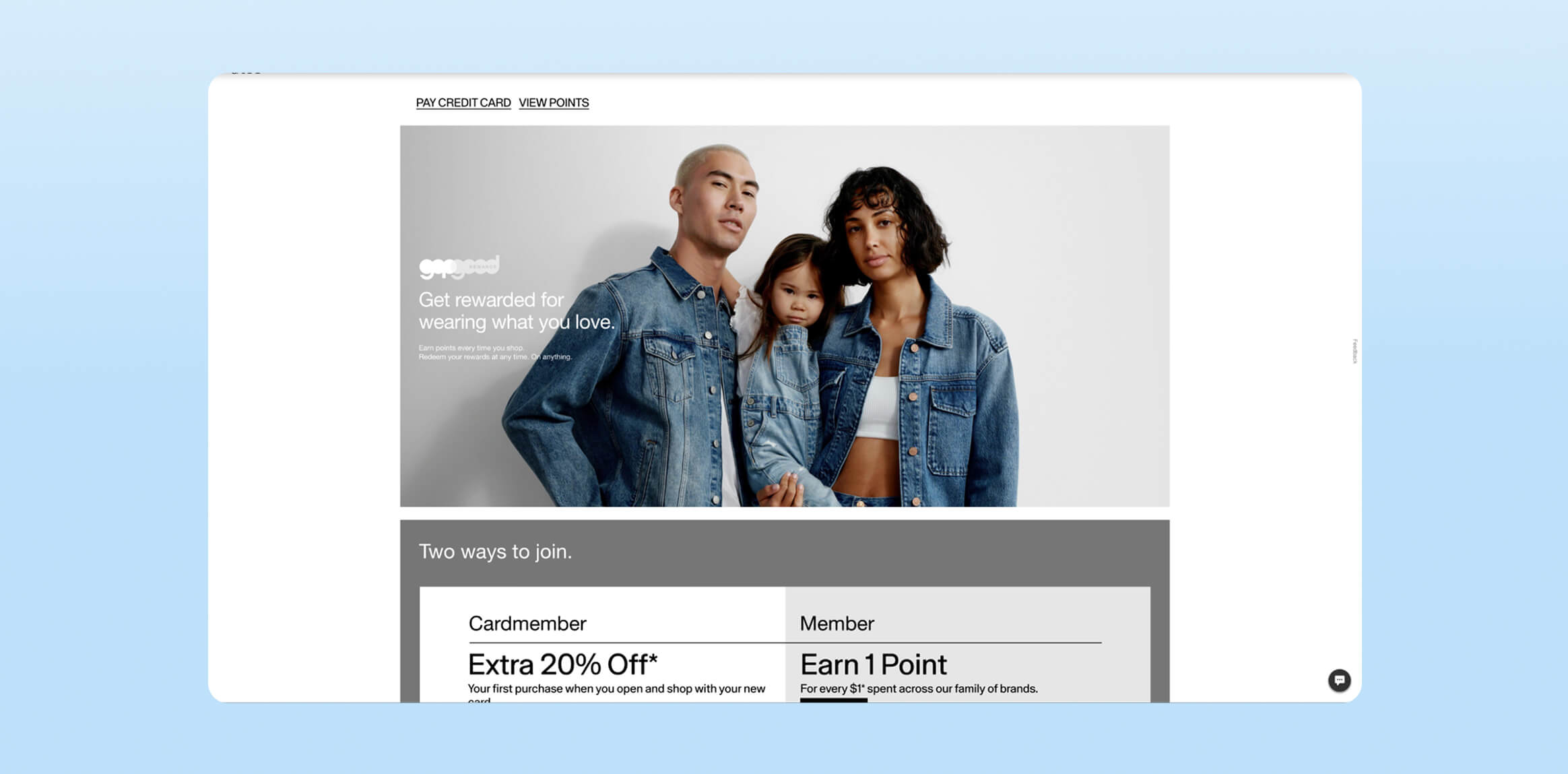
13. My Best Buy Memberships
Why does My Best Buy’s tiered retail rewards program work?
- Offering a free tier alongside mid-tier ($49.99/yr) and premium ($179.99/yr) plans aligns offerings to different customer needs, enabling Best Buy to segment based on willingness to pay and technographic profiles.
- Middle and top-tier members gain early access to deals and exclusive product prices, reinforcing member differentiation and emotional loyalty.
- Total tier includes AppleCare+, product protection, and 24/7 tech support, transforming service costs into a retention lever and creating ongoing value perception.
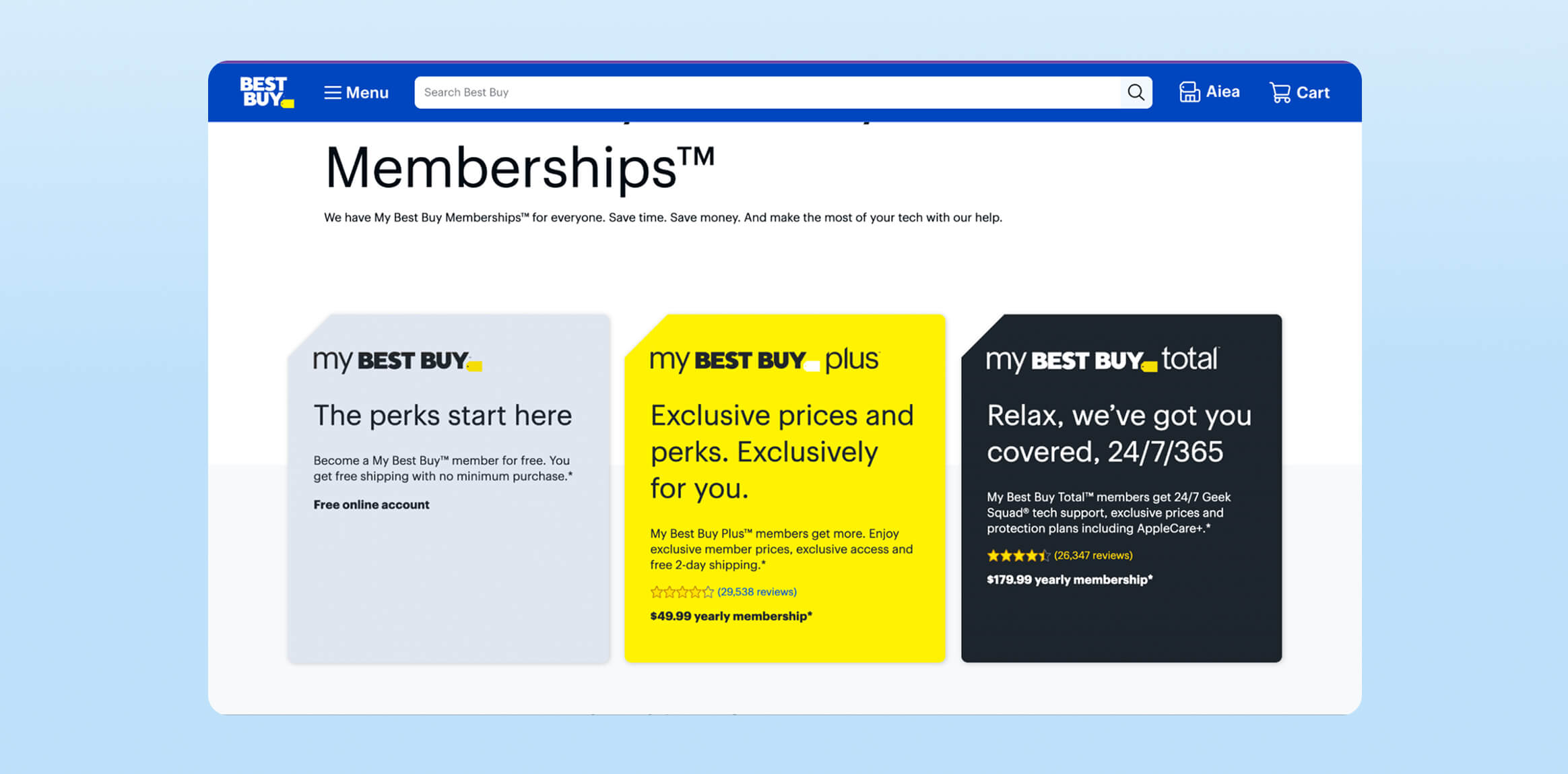
14. Target Circle
Why does the Target retail loyalty program work?
- The free Target Circle simplifies loyalty via auto-applied deals and personalized digital offers for teachers and college students, driving broad adoption. While Circle 360 ($99/yr or $10.99/mo) adds convenience layers like same-day delivery and extended returns, it upsells core shoppers through clear value incentives.
- Paid tier provides same-day delivery with no markups, extended returns, and early sale access, perfect for busy, digital-first consumers.
- Purchase behavior feeds personalization engines that drive precise offers and fuel long-term customer lifetime value strategies.
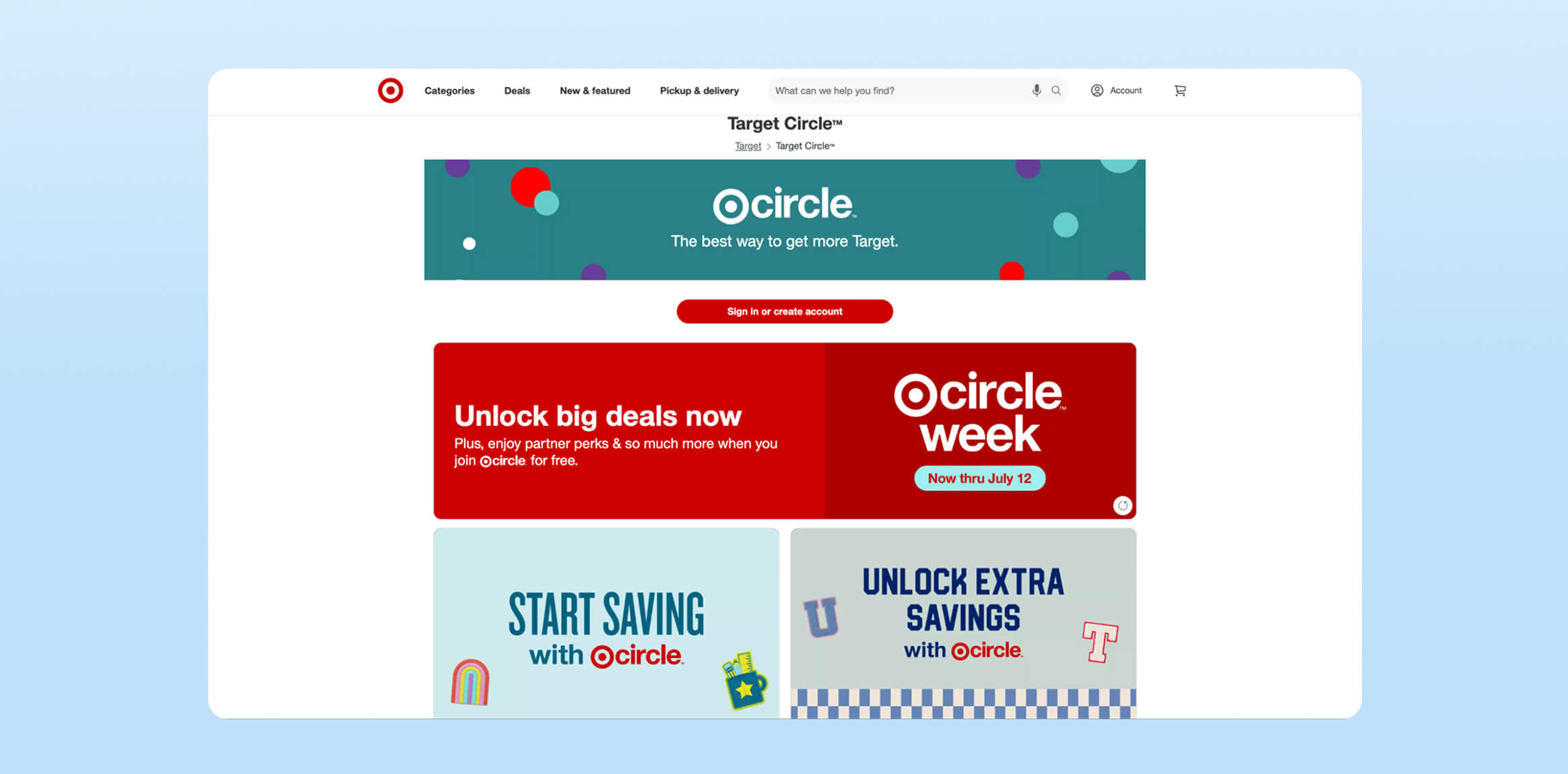
15. Kohl’s Rewards
Why does Kohl’s Rewards program work?
- Members earn 5% Kohl’s Cash on everyday purchases, or 7.5% when using the Kohl’s Card, using a structure that’s easy to understand and compelling for high-frequency spenders.
- Kohl’s Rewards balance is converted and issued in $5 Kohl’s Cash increments on the first of the following month, lowering redemption friction.
- Members enjoy personalized perks, special birthday gifts, and access to monthly exclusive savings, enhancing the experience.
- The Apply Today Save 40% hook creates a powerful urgency trigger that converts shoppers into loyalty members instantly.
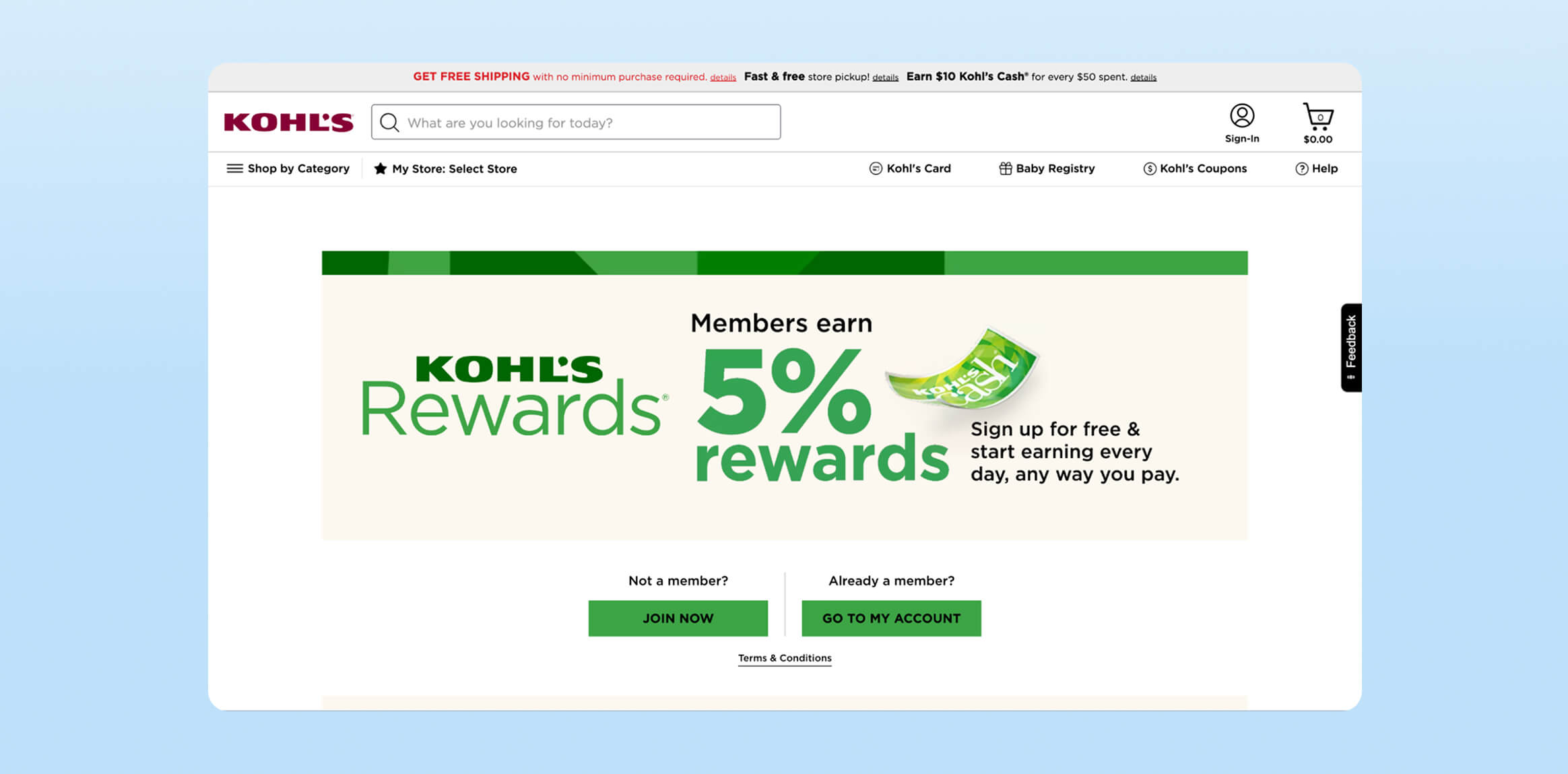
How CleverTap Powers Next-Gen Loyalty Programs
As the world’s leading customer engagement platform, CleverTap gives brands the tools to build next-generation loyalty programs, driven by real-time customer intelligence, seamless automation, and personalized engagement across every channel.
Here’s how CleverTap powers these loyalty experiences:
- The platform enables marketers to deliver dynamic promotions and loyalty experiences by using real-time customer insights and behavior-triggered campaigns.
- CleverTap can instantly segment and target loyalty members based on behavior or recent activity, automating personalized push notifications or emails.
- It equips retailers to scale loyalty programs without heavy IT overhead, using data-driven automation to boost engagement.
- CleverTap, powered by its proprietary TesseractDB™, stores up to 10 years of user activity and 10,000+ data points per user per month. This gives marketers the context to reward long-term behavior, like birthdays, anniversaries, or past loyalty milestones, with precision.
- Personalize every reward with precision, using flexible rules, customer segments, and omnichannel orchestration. This means a retailer can easily set up “early sales access” campaigns for high-value customers or trigger bonus rewards for customers who haven’t shopped recently.
- With Clever.AI, marketers can automatically optimize loyalty campaigns by predicting churn, identifying high-value actions, and routing users through the highest-performing journey paths, without manual guesswork.
- CleverTap’s Real Impact dashboards help measure the business outcomes of loyalty initiatives, such as increases in repeat purchases, upsell rates, and overall customer lifetime value, so you always know what’s working.
- Loyalty programs can be scaled across 15+ channels, including Email, WhatsApp, Push, Web Pop-ups, In-app, SMS, and more, ensuring every message reaches users on their preferred channel, with consistent context.
Build smarter loyalty programs with CleverTap’s real-time insights, personalization, and omnichannel automation.
Design Your Retail Loyalty Program
Retail and store loyalty programs are powerful tools for driving repeat business and deeper customer relationships. By offering tailored rewards and personalized experiences, retailers can increase customer lifetime value, gain insights from member data, and set themselves apart from competitors.
The 15 examples above show how leading retailers use points, tiers, subscriptions, and other creative perks to keep customers coming back. With the right strategy, technology, and ongoing optimization, you can craft a loyalty program that turns casual shoppers into lifelong brand advocates.
Support your loyalty strategy with personalized, omnichannel engagement. Try CleverTap now.
Shivkumar M 
Head Product Launches, Adoption, & Evangelism.Expert in cross channel marketing strategies & platforms.
Free Customer Engagement Guides
Join our newsletter for actionable tips and proven strategies to grow your business and engage your customers.

